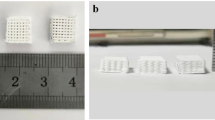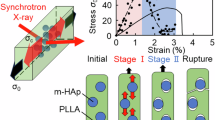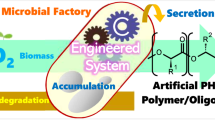Abstract
Poly(l-lactic acid-co-glycolic acid)/hydroxyapatite (PLGA/HAp) composites were fabricated by the in situ polymerization of l-lactide and glycolide in porous HAp disks, using lipase MM, derived from Mucor miehei, as a catalyst. Various PLGA/HAp composites were obtained by changing the feed ratio of l-lactide and glycolide. The fourier transform infrared spectroscopy, scanning electron microscopy and porosity measurements showed that the porous HAp was completely filled with PLGA after polymerization at 100 °C for 9 days. Lactyl unit fractions (FL) of obtained PLGA calculated from the 1H nuclear magnetic resonance were consistent with the feed fraction of l-lactide (fL). The PGA/HAp, PLGA20/HAp, PLGA50/HAp, PLGA80/HAp and PLLA/HAp composites showed maximum bending strengths of 91.1 MPa, 78.8 MPa, 73.4 MPa, 54.3 MPa and 67.0 MPa, respectively. These values were 4.7–2.8 times greater than that of the untreated porous HAp disks and were suitable for artificial bone materials. The cell adhesion and proliferation properties of these materials with osteoblast-like MC3T3-E1 cells suggest that these PLGA/HAp composites have suitably bioactive surfaces. The PLGA/HAp composites showed higher alkaline phosphatase activity after cultivation of rat bone marrow stromal cells.
Similar content being viewed by others
Log in or create a free account to read this content
Gain free access to this article, as well as selected content from this journal and more on nature.com
or
References
Bucholz, R. W., Carlton, A. & Holmes, F. E. Hydroxyapatite and tricalcium phosphate bone graft substituents. Orthop. Clin. North Am. 18, 323–334 (1987).
van Blitterswijk, C. A., Grote, J. J., Kuijpers, W., Daems, W. T. & de Groot, K. Macropore tissue ingrowth: a quantitave and qualitative study on hydroxyapatite. Biomaterials 7, 137–143 (1986).
Suchanek, W. & Yoshimura, M. Processing and properties of hydroxyapatite-based biomaterials for use as hard tissue replacement implants. J. Mater. Res. 13, 94–117 (1998).
Nazhat, S., Joseph, R., Wang, M., Smith, R., Tanner, K. & Bonfield, W. Dynamic mechanical characterization of hydroxyapatite reinforced polyethylene: effect of particle size. J. Mater. Sci. Mater. Med. 11, 621–628 (2000).
Chu, K., Oshida, Y., Hancock, E., Kowolik, M., Barco, T. & Zunt, S. Hydroxyapatite/PMMA composites as bone cements. Biomed. Mater. Eng. 14, 87–105 (2004).
Ishii, S., Tamura, J., Furukawa, T., Nakamura, T., Matsusue, Y., Shikinam, Y. & Okuno, M. Long-term study of high-strength hydroxyapatite/poly(L-lactide) composite rods for the internal fixation of bone fractures: a 2–4 year follow-up study in rabbits. J. Biomed. Mater. Res. B Appl. Biomater. 66, 539–547 (2003).
Matsusue, Y., Hanafusa, S., Yamamuro, T., Shikinami, Y. & Ikada, Y. Tissue reaction of bioabsorbable ultrahigh strength poly(L-lactide) rod. A long-term study in rabbits. Clin. Orthop. Relat. Res. 317, 246–253 (1995).
Joukainen, A., Partio, E., Waris, P., Joukainen, J., Kröger, H., Törmälä, P. & Rollanen, P. Bioabsorbable screw fixation for the treatment of ankle fractures. J. Orthop. Sci. 12, 28–34 (2007).
Backstrom, A., Raiha, J., Valimaa, T. & Tulamo, R. Repair of radical fractures in toy breed dogs with self-reinforced biodegradabe bone plates, metal screws, and light-weight external coaptation. Vet. Surg. 34, 11–17 (2005).
Makela, P., Pohjonen, T., Tormala, P., Waris, T. & Ashammakhi, N. Strength retention properties of self-reinforced polyL-lactide (SR-PLLA) sutures compared with polyglyconate (Maxon) and polydioxanone (PDS) sutures. An in vitro study. Biomaterials 23, 2587–2592 (2002).
Suriyan, R., Yupaporn, R., Wimonlak, S. & Nitinat, S. Effects of mixing technique and filler content on physical properties of bovine bone-based CHA/PLA composites. J. Appl. Polym. Sci. 122, 2433–2441 (2011).
Aydin, E., Planell, J.A. & Hasirci, V. Hydroxyapatite nanorod-reinforced biodegradable poly(L-lactic acid) composites for bone plate applications. J. Mater. Sci. Mater. Med. 22, 2413–2427 (2011).
Sugiyama, N., Kunibu, R., Yoshizawa-Fujita, M., Takeoka, Y., Aizawa, M. & Rikukawa, M. Ring-opening bulk polymerization of L-lactide in porous hydroxyapatite. Chem. Lett. 36, 1476–1477 (2007).
Aizawa, M., Porter, A., Best, S. & Bonfield, W. Ultrastructural observation of single-crystal apatite fibers. Biomaterials 26, 3427–3433 (2005).
Ehrenfried, L., Farrar, D. & Cameron, R. Degradation properties of co-continuous calcium-phosphate-polyester composites. Biomacromolecules 10, 1976–1985 (2009).
Wiegand, T., Karr, J., Steinkruger, J., Hiebner, K., Simetich, B. & Beatty, M. Recognition of anorganic mammalian bone by surface-initiated polymerization of L-lactide. Chem. Mater. 20, 5016–5022 (2008).
Sugiyama, N., Ohno, T., Kunibu, R., Aizawa, M., Takeoka, Y. & Rikukawa, M. In situ preparation of poly(L-lactic acid)/hydroxyapatite composites as artificial bone materials. Kobunshi Ronbunshu 70, 185–192 (2013).
Griffith, L. G. Polymeric biomaterials. Acta. Mater. 48, 263–277 (2000).
Rashkov, I. & Manolova, N. Synthesis, characterization, and hydrolytic degradation of PLA/PEO/PLA triblock copolymers with short poly(L-lactic acid) chains. Macromolecules 29, 50–56 (1996).
Jeong, B., Bae, Y. H. & Kim, S. W. Thermoreversible gelation of PEG-PLGA-PEG triblock copolymer aqueous solutions. Macromolecules 32, 7064–7069 (1999).
Lee, J.-W. & Gardella, J. A. In vitro hydrolytic surface degradation of poly(glycolic acid): Role of the surface segregated amorphous region in the induction period of bulk erosion. Macromolecules 34, 3928–3937 (2001).
Aizawa, M., Howell, F., Itatani, K., Yokogawa, Y., Nishizawa, K., Toriyama, M. & Kameyama, T. Fabrication of porous ceramics with well-controlled open pores by sintering of fibrous hydroxyapatite particles. J. Ceram. Soc. Jpn. 108, 249–253 (2000).
Pearson, R. Toughening of Plastic. ACS Symposium Series 759, 1–12 (2000).
Standard specification for poly(glycolide) and poly(glycolide-co-lactide) resins for surgical implants with mole fractions greater than or equal to 70 % glycolide ASTM F2313-10 (2008)
Fischer, E. W., Sterzel, H. J. & Wegner, G. Investigation of the structure of solution grown crystals of lactide copolymers by means of chemicals reactions. Kolloid-Z. Z. Polym. 251, 980–990 (1973).
Sugiyama, N., Yanagi, Y., Yoshizawa-Fujita, M., Aizawa, M., Takeoka, Y. & Rikukawa, M. DNA-templated fabrication of biphasic calcium phosphate ceramics with a bimodal pore structure for tissue engineering. Chem. Lett. 42, 465–467 (2013).
Aizawa, M., Ito, M., Takeoka, Y., Rikukawa, M. & Okada, I. Fabrication of porous teicalcium phosphate ceramics from calcium-phosphate fibers for a matrix of biodegradable ceramics/polymer hybrids. Phosphorus Res. Bull. 17, 209–210 (2004).
Matsumura, S. Enzyme-catalyzed synthesis and chemical recycling of polyesters. Macromol. Biosci. 2, 105–126 (2002).
Matsumura, S., Mabuchi, K. & Toshima, K. Novel ring-opening polyerization of lactide by lipase. Macromol. Symp. 130, 285–304 (1998).
Tanaka, H., Chikazawa, M., Kandori, K. & Ishikawa, T. Influence of thermal treatment on the structure of calcium hydroxyapatite. Phys. Chem. Chem. Phys. 2, 2647–2650 (2000).
Hong, Z., Zhang, P., He, C., Qiu, X., Liu, A., Chen, L., Chen, X. & Jing, X. Nano-composite of poly(L-lactide) and surface grafted hydroxyapatite: mechanical properties and biocompatibility. Biomaterials 26, 6296–6304 (2005).
Verheyen, C., de Wijn, J., Blitterswijk, C. V. & de Groot, K. Evaluation of hydroxyapatite/poly(L-lactide) composites: mechanical behavior. J. Biomed. Mater. Res. 26, 1277–1296 (1992).
Kokubo, T., Kim, H. & Kawashita, M. Novel bioactive materials with different mechanical properties. Biomaterials 24, 2161–2175 (2003).
White, A. & Best, S. Bone Repair Biomaterials (eds Planell, J., Best, S., Lacroix, D. & Merolli, A.), 122–125 (CRC Press, London, UK, 2009).
Kannan, S., Lemos, A. & Ferreira, J. Synthesis and mechanical performance of biological-like hydroxyapatites. Chem. Mater. 18, 2181–2186 (2006).
Orefice, R., West, J., LaTorre, G., Hench, L. & Brennan, A. Effect of long-term in vitro testing on the properties of bioactive glass-polysulfone composites. Biomacromolecules 11, 657–665 (2010).
Miyazaki, T., Imamura, M., Ishida, E., Ashizuka, M. & Ohtsuki, C. Apatite formation abilities and mechanical properties of hydroxyethylmethacrylate-based organic-inorganic hybrids incorporated with sulfonic groups and calcium ions. J. Mater. Sci. Mater. Med. 20, 157–161 (2009).
Isama, K. & Tsuchiya, T. Enhancing effect of poly(L-lactide) on the differentiation of mouse osteoblast-like MC3T3-E1 cells. Biomaterials 24, 3303–3309 (2003).
Acknowledgements
This work was partly supported by JSPS KAKENHI Grant-in-Aid for Scientific Research on Innovative Areas ‘Fusion Materials’.
Author information
Authors and Affiliations
Corresponding author
Additional information
Supplementary Information accompanies the paper on Polymer Journal website
Supplementary information
Rights and permissions
About this article
Cite this article
Takeoka, Y., Hayashi, M., Sugiyama, N. et al. In situ preparation of poly(l-lactic acid-co-glycolic acid)/hydroxyapatite composites as artificial bone materials. Polym J 47, 164–170 (2015). https://doi.org/10.1038/pj.2014.121
Received:
Revised:
Accepted:
Published:
Issue date:
DOI: https://doi.org/10.1038/pj.2014.121
This article is cited by
-
Enhancing Cell Proliferation and Osteogenic Differentiation of MC3T3-E1 Pre-osteoblasts by BMP-2 Delivery in Graphene Oxide-Incorporated PLGA/HA Biodegradable Microcarriers
Scientific Reports (2017)
-
Effect of solution viscosity on the production of nanoribbon network hydrogels composed of enzymatically synthesized cellulose oligomers under macromolecular crowding conditions
Polymer Journal (2017)
-
Macromolecular templates for biomineralization-inspired crystallization of oriented layered zinc hydroxides
Polymer Journal (2017)
-
Incorporation of surface modified graphene nanoplatelets for development of shape memory PLA nanocomposite
Fibers and Polymers (2016)
-
Osteoinduction and proliferation of bone-marrow stromal cells in three-dimensional poly (ε-caprolactone)/ hydroxyapatite/collagen scaffolds
Journal of Translational Medicine (2015)



